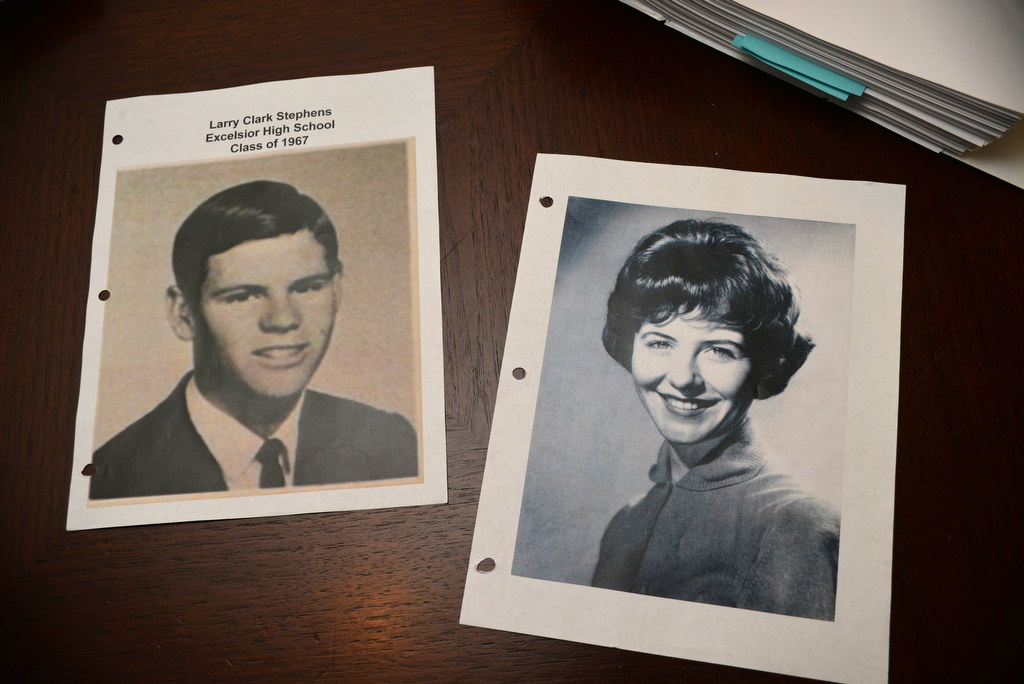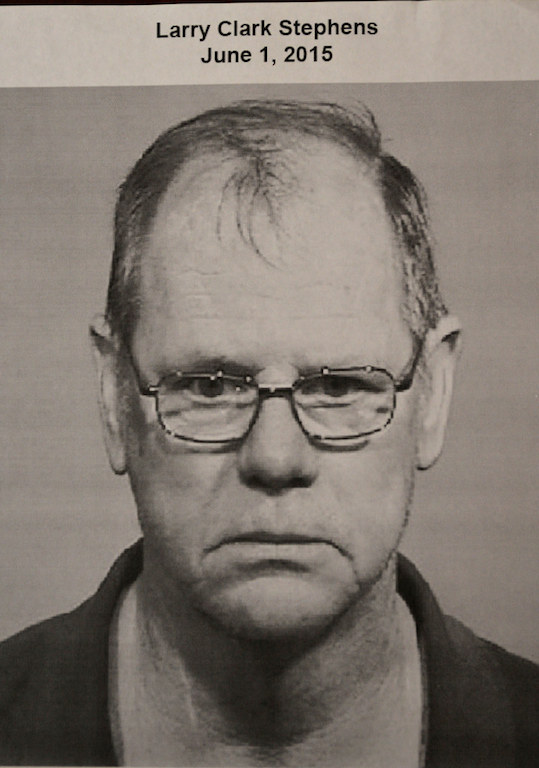Editor’s note: On Friday, May 4, 2018, Larry Clark Stephens, 68, of Santa Rosa, was sentenced in Orange County Superior Court to life in state prison. An Orange County jury on March 6, 2018, found Stephens guilty of one felony count of first-degree murder in the 1974 strangling of a woman in her apartment in La Palma. Below is a story about the cold case Behind the Badge published on July 7, 2015.
She hopped into the shower to freshen up for the double date at her best friend’s home in Seal Beach.
She picked up a razor and glided it over her right leg.
Just before leaving work around 5 p.m. to go home and clean up, Patricia Ann “Annie” Ross had joked to the two women to whom she had just sold her plant shop that the hair on her legs was so long she could braid it.
Also just before leaving, Ross, 31, made a cryptic comment about her evening plans:
“I have a hot date that will probably turn out to be lukewarm.”
Those are Ross’ last known words alive.
A concerned friend found her around 8:15 that night after she failed to show up at the Seal Beach get-together, as planned, between 6 and 6:30 p.m.
Ross was found nude and lying face down in her bed in her one-bedroom, ground-floor apartment in La Palma, her right leg cleanly shaved but her left leg unshaven.
Some blood was by her head on the bed sheets.
The divorcee from Tucson, Ariz., who had a habit of leaving open the sliding-glass door to the enclosed patio of her unit open so her small dog could get in and out, and so fresh air could feed her beloved houseplants, had been brutally sodomized with an unknown object and strangled.
Cause of death: asphyxiation.
It was Wednesday, Dec. 11, 1974.
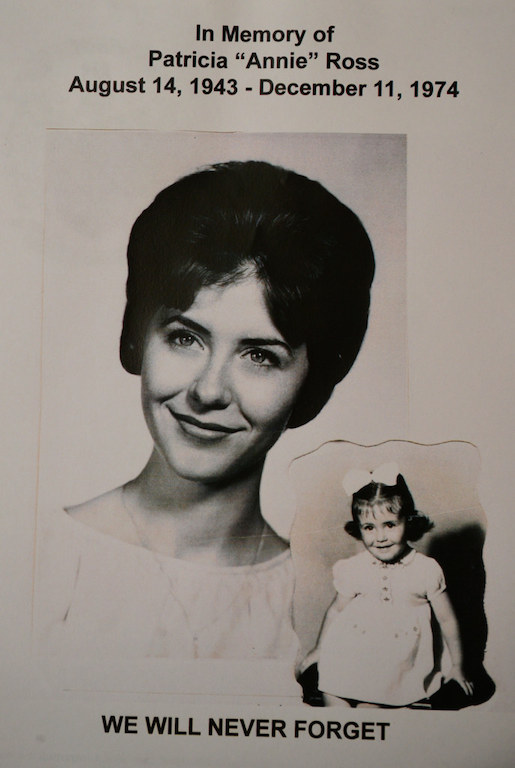
La Palma detectives never gave up searching for the killer of Patricia “Annie” Ross, shown here in her mid-20s and as a girl.
Photo courtesy of La Palma PD
Until this March, the mystery of who killed Ross – a petite brunette with a small circle of friends, with a younger brother and parents in Arizona she was close to — had confounded more than a half-dozen La Palma detectives who, over the decades, took cracks at trying to shake out leads in the case, which went cold in mid-1975.
Could the killer have been the man Ross had been casually dating when she was murdered — her “lukewarm” date who showed up late at the Seal Beach gathering with a cut above his eye and a bloody T-shirt?
What about the orthopedic resident who had a girlfriend but also was believed to be seeing Ross at the time of her death?
Or what about the man who recently had interviewed her for a job as a secretary at an aerospace firm — she nailed the interview, and was to start the job in three days — the one who had remarked, during the interview, how pretty she was?
Or maybe Ross’ death had something to do with the sale of her plant business, Annie Greenthings?
Ross was supposed to bring pizza to the Seal Beach party. Could a pizza delivery person somehow have been involved in her death — among the most horrifically up-close-and-personal ways to die?
On a recent weekday morning, Capt. Jim Engen sat beside Det. Paul Bracciodieta at La Palma PD headquarters, two massive white binders resting on the table before them.
On the cover of one of the foot-thick case files, in all caps below two black-and-white photos of Ross as a girl and in her mid-20s, were these words:
WE WILL NEVER FORGET
For more than four decades, Engen and his predecessors at the relatively tiny La Palma PD never forgot. After all, La Palma gets maybe one homicide every three years — and the Ross killing was the city’s only unsolved murder.

The downstairs apartment in La Palma where Patricia “Annie” Ross was murdered back in 1974. She had a habit of leaving her sliding-glass patio door open.
Photo by Steven Georges/Behind the Badge OC
Now, sometime this week, a 65-year-old suspect is scheduled to arrive in Santa Ana to face charges in the murder of Ross — a woman described by those who knew her as instantly likeable, but who mostly kept to herself.
A woman whose attempts to start a new life in Orange County were viciously snuffed out when she was at her most vulnerable — home alone, taking a shower.
***
Engen was 9 years old when Ross was murdered.
Bracciodieta wasn’t even born.
Both now are veteran cops with the La Palma PD: Engen, 49, has been with the agency for 24 years, Bracciodieta 13.
Both started working together on the Ross case in 2007.
As in all suspected homicides, detectives focus their efforts on finding out everything they can about the suspect or suspects – and the social, business and personal circles of the victim or victims.
La Palma detectives talked to everyone in the Brookside Apartment Complex, at 5600 Orangethorpe Ave., to see if anyone had seen or heard anything unusual in apartment No. 4511 beginning at around 5 p.m. on Dec., 11, 1974 — when the timeline of Ross’ murder starts, with her leaving the plant shop.
The original police report lists a total of 53 people — neighbors, friends, business associates — that police interviewed in the hopes of shaking out leads.
Ross, a wisp of a woman at 5 feet 1 and 95 pounds, lived near the plant shop in a modestly decorated apartment whose décor reflected the groovy era: a beanbag, macramé holders for hanging plants, a sofa with a loud floral print.
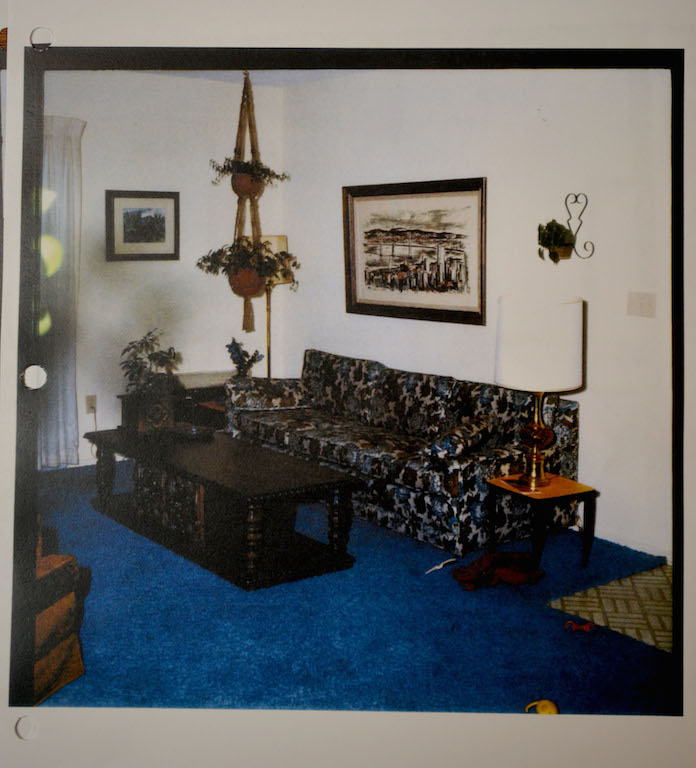
Ross’ living room. She had rushed home to freshen up to go to a party in Seal Beach. She never made it. Photo courtesy of La Palma PD.
She had married young, at 18, in Arizona but divorced a few years later. She wanted children; her husband, Frank Ross, couldn’t because of a vasectomy.
After the split, she still loved him and had bouts with depression.
Frank Ross occasionally would visit Annie in California, where she had relocated to start over. She was known to smoke marijuana now and then and liked screwdrivers and wine, but was not a heavy drinker.
She dated.
She went into business with a male friend — they weren’t dating — to open the plant shop, but it struggled.
Money got tight, so Ross and her partner agreed to sell Annie Greenthings for $3,000.
The deal was struck in Ross’ apartment the night before she was killed.
The buyers gave her a cashier’s check for $2,000, with the rest to be worked out later. Ross needed the money more than her partner, so he agreed that the $2,000 should go to her.
It was a fresh start for Ross, and things were looking up. She was planning to move to Redondo Beach and start her new job as a secretary at the aerospace firm, and was in the process of trying to reconcile with her ex-husband.
Then 5 p.m. rolled around, and soon Ross would be dead after a struggle so violent one of her contact lenses got knocked out onto her cheek.
Her brown leather purse was hanging on the doorknob of the bathroom.
Cops later found in it an open pack of Marlboro cigarettes and other items, including the cashier’s check for $2,000 made out to Annie Greenthings.

Jim Engen, now a captain at the La Palma PD, was challenged by his then-sergeant in the detective unit to solve the murder of Ross when Engen became a detective in 1996, when the case was 22 years old. Photo by Steven Georges/Behind the Badge OC
Detectives talked to the women who bought her plant shop, but quickly ruled them out as suspects.
What about the guy with the bloody T-shirt and cut above his eye whom Annie was dating off and on — the presumed target of her “lukewarm” comment that evening?
His story about being elbowed during a basketball game at John F. Kennedy High School in La Palma the night Ross was supposed to meet him and the two others in Seal Beach checked out.
His alibi was airtight.
And the aerospace firm manager who made the “pretty” comment?
He also passed the sniff test.
Ross never had a chance to order the pizza she planned to bring to Seal Beach, so the theory of a killer pizza deliveryman was ruled out.
Detectives were left with a whole lot of nothing.
Based on interviews with residents of the Brookside Apartment Complex, they determined that Ross was accosted around 5:15 p.m., most likely while showering, and murdered between then and 5:45 p.m.
Her small dog was heard barking at around 5:15 p.m. but by 5:45 p.m. the barking had become muffled.
Cops later found Ross’ dog unharmed in a drawer in her bedroom.
Neighbors told police it was unusual that the living room drapes had been drawn closed and the sliding-glass door had been locked — indicating that the killer left through the front door after gaining entry through the open sliding-gas door.
There were no signs of a forced entry.
Detectives found traces of blood in the bathroom, bedroom and on the inside of a window, but they didn’t know whose blood it was. DNA collection still was more than two decades away from its infancy as an investigative tool.
In 1979, five years after Ross’ murder, another woman was raped in the same apartment complex.
Police caught the suspect, but he didn’t pan out as a suspect in the Ross killing.
Similar crimes in surrounding cities also turned into dead ends.
And so the Ross case remained cold — the copious volumes of police reports, coroner findings, evidence from the murder scene and other documents and materials stuffed into three large white boxes collecting dust in a room at the La Palma PD.

La Palma Police Det. Paul Bracciodieta wasn’t even born with Ross was brutally slain. Photo by Steven Georges/Behind the Badge OC
***
When Engen rotated into the detectives unit in 1996, his sergeant issued a challenge:
Solve the Ross murder.
“Go into the evidence room and start documenting every bit of evidence we have on this case,” Sgt. Ed Ethell told him and other detectives. “Go through the archives and find out what has been done and has not been done.”
Recalled Engen: “I was eager and excited. I’m thinking, ‘Here I am a young detective and the sergeant has given me permission to look into this.’”
So he did.
In 1997, the Orange County Sheriff’s Crime Lab came back with a profile of the DNA found in Ross’ apartment: unknown male, from blood found on Ross’ comforter and a window.
Working with members of the Orange County Homicide Task Force, which is run by the Orange County District Attorney’s Office, Engen and other investigators looked at serial killers active at the time, but there were no hits in the national DNA Index System, where forensic DNA evidence from violent crime investigations is stored.
Engen rotated out of the detective bureau in 1999.
It wasn’t until 2007, when Bracciodieta became a detective and Engen was rotated back into the unit as his boss, that Engen issued the same challenge he was issued back in 1996.
“There’s a cold case I want to bring back to life,” Engen told his small team of detectives.
“I want to do this,” Bracciodieta said.
Go for it, Engen told him.
Bracciodieta made copies of the original 41-page police report and highlighted every name. The plan was to contact each person again and eliminate him or her as a suspect by getting DNA to match against the federal database.
“The DNA was faceless,” Engen said. “We wanted to put a face on it.”
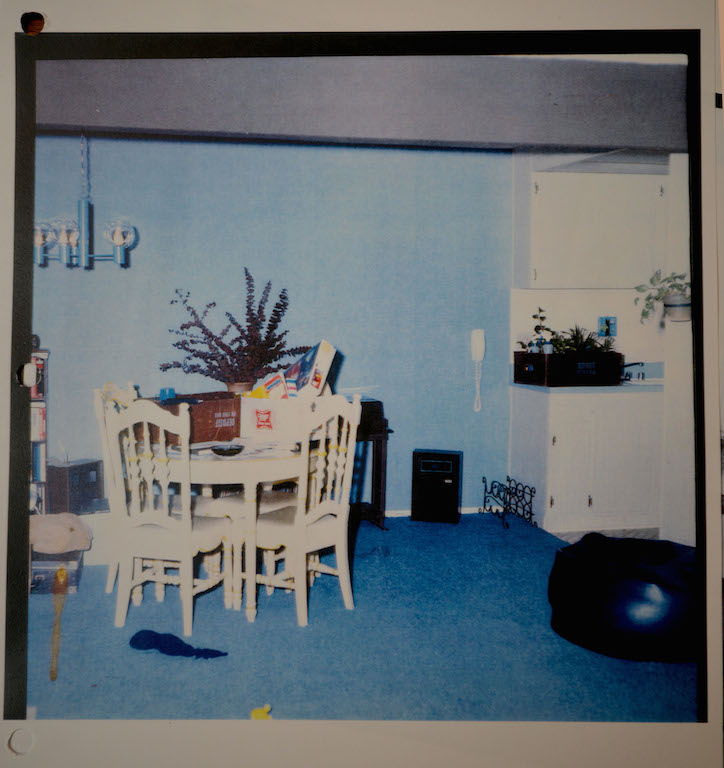
Ross’ apartment the night she was murdered. She was about to start a new job and move. Photo courtesy of La Palma PD
The La Palma PD officially reopened the case in 2008 with help from the O.C. District Attorney’s Office and the Orange County Cold Case Homicide Task Force.
In poring over the reams of material, the name of the orthopedic resident believed to be seeing Ross at the time of her death came up in an early 1975 interview with Ross’ best friend — the woman who hosted the Seal Beach get-together the night of her murder.
The doctor never was interviewed back in the mid-’70s, which to Engen and Bracciodieta proves the value of having fresh eyes look at old cases.
The now successful orthopedic surgeon reluctantly agreed to be interviewed at his home in San Gabriel, but acted nervous and refused to provide a DNA sample.
“You’re just talking to me now?” he asked the detectives.
The doctor denied knowing Ross.
Two days later, he had his lawyer contact the La Palma detectives to tell them his client would not provide a DNA sample and would not answer any more questions.
Engen and Bracciodieta had a strong enough hunch to put a tail on the doctor.
They followed the doctor and were able to retrieve cigarette butts and a paper cup he used after drinking vodka in his car — he visited two liquor stores — after a hospital shift.
They submitted his DNA to the O.C. Crime Lab.
No hit.
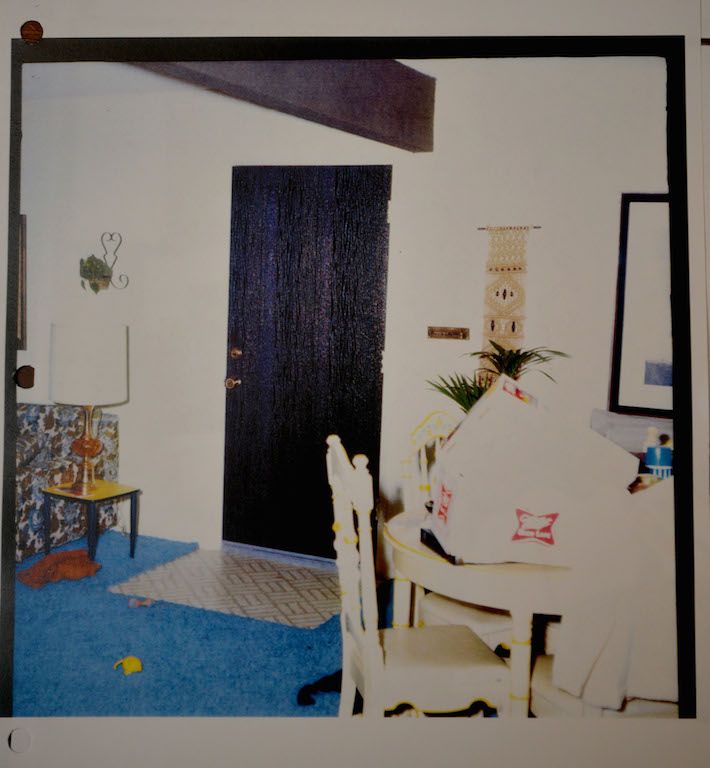
The front door of Ross’ apartment. There was no forced entry. Detectives believe the killer entered through the open patio door. Photo courtesy of La Palma PD
In November 2008, another name in the police report caught the attention of the detectives: Paul Williams.
He was living right above Ross’ apartment when she was murdered.
Detectives interviewed Williams four days after the murder, but he said he heard and saw nothing.
But two weeks after the slaying, La Palma police paid Williams another visit: this time to question him about an unrelated incident.
A female neighbor who lives across from Williams called cops after she saw, from the inside of her apartment, someone turn the doorknob on her front door.
She didn’t know Williams by name, but told cops she thought he or a second man she often saw in his apartment probably were the ones who tried to get into her apartment.
Williams was alone when cops talked to him that night in late December 1974. He denied having anything to do with the doorknob incident.
Cops asked him who the other man was who often was seen in his apartment.
“My friend, Larry Stevens,” Williams told them.
That name — Larry Stevens — appears on page 34 of the original police report.
Stevens never was interviewed back in 1974.
In early 2009, after finding Williams’ address in Lake Havasu, the detectives paid him a visit to ask about his old friend, Larry Stevens.
No middle name.
No date of birth.
Just another name to cross off the list of suspects — or not.
***
Williams told Engen and Bracciodieta he hadn’t seen his old friend, Larry Stevens, since the early ’70s — not too long after Ross’ murder.
He said Stevens was his buddy at Excelsior High School in Norwalk.
After the interview, Engen logged onto classmates.com and found a picture of a Larry Stephens in the yearbook. The original police report had his last name spelled incorrectly.
“That’s all we had,” Engen said.
The detectives ran a criminal check and found a Larry Stephens, date of birth Dec. 23, 1949, living in the Santa Rosa area in Sonoma County.
That Larry Stephens would have been 24 when Ross was murdered.
They ran a criminal check and found arrests for domestic violence in 2008 and 2007. One police report described Stephens putting his hands on the neck of his then-wife. The wife, in the report, told police Stephens was quick to anger.
Intrigued, Engen and Bracciodieta again talked to Williams and learned more about Stephens — including the name of his first wife, now living in Oceanside.
They paid her a visit.
“She turned white,” Engen recalled.
The woman told the detectives that the 6-foot-tall, 190-pound Stephens was a drinker who became violent — especially when drunk.
“Do you think he’s capable of committing murder?” Engen asked her.
She said: “If he’s mad enough, oh yeah.”
***
A picture of Stephens emerged:
After high school, he was drafted by the U.S. Army and served in Vietnam for about a year driving ambulances.
After returning home he bounced around, performing odd jobs such as a lumberjack in Oregon and working on a fishing boat in San Diego.
At the time of Ross’ murder, Stephens was divorced and not handling the breakup very well.
He had logged some run-ins with the Buena Park PD, and appeared to be staying at the homes of several friends — including Paul Williams, who lived above Ross.
The La Palma detectives determined Stephens left Orange County in 1977.
“He was a person of high interest,” Bracciodieta said of the suspect in 2009.
But they didn’t have enough on Stephens to get a warrant to collect his DNA.
More years passed.
Periodically, Engen and Bracciodieta would run criminal checks on Stephens to see if anything turned up. After Jan. 1, 2009, any California resident arrested on suspicion of committing a felony had to provide a sample of DNA via a mouth swab.
But nothing on a Larry Clark Stephens, date of birth Dec. 23, 1949, turned up.
Until May 13 this year.
***
Engen was sitting in his office.
He had just had lunch when the call from the O.C. Crime Lab came in.
“We have some news. We have a hit on your 1974 homicide.”
Engen didn’t wait for the name.
“Larry Clark Stephens?
“Yep.”
Engen called Bracciodieta.
He, too, didn’t wait for a name.
“Larry Stephens?” Bracciodieta asked his boss.
“Yes.”
In mid-March 2015, Stephens — a retired postal worker — had been arrested on suspicion of felony domestic violence and other charges in Sonoma County.
He and his current wife had been drinking.
When Santa Rosa cops confronted him, Stephens approached them holding two butcher knives.
He almost got shot.
They used a Taser to subdue him.
After the DNA hit, Engen and Bracciodieta, working with investigators and prosecutors at the OCDA, came up with a plan: visit Stephens while he was out on bail on the domestic violence charge.
The detectives saw Stephens exit his mobile home.
He was wearing white shorts, sneakers and a blue-collared shirt.
It was about 3:15 p.m. on June 1.
Stephens was going for a walk.
Engen and Bracciodieta approached him.
“Larry?” Engen asked.
“Yes.”
They identified themselves as officers with the La Palma PD.
Stephens was friendly, Engen recalled.
“Larry Stephens?”
“Indeed.”
“Do you mind if we talk to you for a bit?”
Stephens denied ever knowing a Patricia Ann “Annie” Ross or ever being in her apartment.
After about an hour after talking to Stephens in a pool area, the detectives arrested him, without incident, on suspicion of killing Ross. News of the arrest went public June 3.
This Monday, June 6, Stephens made a court appearance in Sonoma County to answer to the domestic violence charges. He was sentenced to 16 months in jail for misdemeanor spousal battery and felony obstructing an executive officer for the domestic violence incident on March 21. The judge ruled he can serve that sentence in any penal institution.
Now Stephens is on his way to Orange County to face charges in the murder of Ross, whose parents are deceased but whose brother is alive.
“We initially were elated, but our work’s only just begun,” Bracciodieta said of the case against Stephens, in which detectives and prosecutors must prove, beyond a reasonable doubt, that he killed Ross.
At this point, he’s only a suspect.
Engen and Bracciodieta credit the work of the original detectives on the case, Vince Giampa (who later became police chief and hired Bracciodieta) and Tom Powers, with helping them crack the mystery of whom, they believe, killed Ross.

Det. Paul Bracciodieta, left, and Capt. Jim Engen started working together on the cold case in 2007. Photo by Steven Georges/Behind the Badge OC
“Yes, there was science involved, but it was about details in the original report,” Bracciodieta said. “It took a fresh set of eyes and a lot of laborious research and analyzing of some information that was in the original 1974 crime report and some of which was not in it at all.”
Engen and Bracciodieta, who over the years spent countless hours off the clock working on the Ross case, didn’t need to elaborate when asked why they persisted in trying to solve the murder.
Instead, they looked at the white folder on the table, the one with the black-and-white photos of a smiling Ross as a girl and as a smiling woman in her mid-20s, and at the four words in all caps below the images:
WE WILL NEVER FORGET
“It was our only unsolved homicide,” Engen said, “and we wanted to find justice for Annie.”
Bracciodieta looked up from the photos of Annie Ross.
“Cold cases,” he said, “are never a lost cause.”
 Behind the Badge
Behind the Badge

